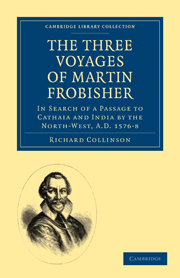 The Three Voyages of Martin Frobisher
The Three Voyages of Martin Frobisher Book contents
- Frontmatter
- INTRODUCTION
- SIR MARTIN FROBISHER, KNT
- STATE PAPERS PREVIOUS TO THE FIRST VOYAGE
- WHAT COMMODITIES AND INSTRUCTIONS MAY BE REAPED BY DILIGENT READING THIS DISCOURSE
- TO THE RIGHT HONOURABLE, MY SINGULAR GOOD MAYSTER, SIR CHRISTOPHER HATTON, KNIGHT, CAPTAINE OF THE QUEENES MAJESTIES GARDE, VIZCHAMBERLAINE TO HIR HIGHNESSE, AND ONE OF HIR MAJESTIES MOST HONOURABLE PRIVIE COUNSALE
- THE PRINTER TO THE READER
- THE FYRST BOOKE OF THE FIRST VOYAGE OF MARTIN FROBISHER, ESQUIER, CAPTAYNE GENERALL FOR THE DISCOVERIE OF THE PASSAGE TO CATAYA AND THE EAST INDIA, BY THE NORTHWEAST, FIRST ATTEMPTED IN ANNO DOM. 1576, THE 15. OF MAY
- STATE PAPERS SUBSEQUENT TO THE FIRST VOYAGE
- ACCOUNT OF THE SECOND VOYAGE, WITH THE INSTRUCTIONS GIVEN TO MARTYNE FURBISHER
- A TRUE REPORTE OF SUCH THINGS AS HAPNED IN THE SECOND VOYAGE OF CAPTAYNE FROBYSHER, PRETENDED FOR THE DISCOVERIE OF A NEW PASSAGE TO CATAYA, CHINA, AND THE EAST INDIA, BY THE NORTH WEST. ANNO DO. 1577
- STATE PAPERS SUBSEQUENT TO THE SECOND VOYAGE
- STATE PAPERS RELATIVE TO THE TRIAL OF THE ORE SUBSEQUENT TO THE SECOND VOYAGE
- STATE PAPERS CONCERNING THE TRIALL OF THE EWR PREVIOUS TO THE THIRD VOYAGE
- STATE PAPERS RELATIVE TO THE OUTFIT FOR THE THIRD VOYAGE
- THE THIRDE VOYAGE OF CAPTAINE FROBISHER, PRETENDED FOR THE DISCOVERIE OF CATAYA, BY META INCOGNITA. ANNO DO. 1578
- ANOTHER ACCOUNT OF THE THIRD VOYAGE, BY EDWARD SELLMAN
- STATE PAPERS SUBSEQUENT TO THE THIRD VOYAGE
- A DESCRIPTIVE CATALOGUE OF RELICS OF FROBISHER'S EXPEDITIONS TO THE ARCTIC REGIONS IN THE YEARS 1576-7-8
- INDEX
- Plate section
- Frontmatter
- INTRODUCTION
- SIR MARTIN FROBISHER, KNT
- STATE PAPERS PREVIOUS TO THE FIRST VOYAGE
- WHAT COMMODITIES AND INSTRUCTIONS MAY BE REAPED BY DILIGENT READING THIS DISCOURSE
- TO THE RIGHT HONOURABLE, MY SINGULAR GOOD MAYSTER, SIR CHRISTOPHER HATTON, KNIGHT, CAPTAINE OF THE QUEENES MAJESTIES GARDE, VIZCHAMBERLAINE TO HIR HIGHNESSE, AND ONE OF HIR MAJESTIES MOST HONOURABLE PRIVIE COUNSALE
- THE PRINTER TO THE READER
- THE FYRST BOOKE OF THE FIRST VOYAGE OF MARTIN FROBISHER, ESQUIER, CAPTAYNE GENERALL FOR THE DISCOVERIE OF THE PASSAGE TO CATAYA AND THE EAST INDIA, BY THE NORTHWEAST, FIRST ATTEMPTED IN ANNO DOM. 1576, THE 15. OF MAY
- STATE PAPERS SUBSEQUENT TO THE FIRST VOYAGE
- ACCOUNT OF THE SECOND VOYAGE, WITH THE INSTRUCTIONS GIVEN TO MARTYNE FURBISHER
- A TRUE REPORTE OF SUCH THINGS AS HAPNED IN THE SECOND VOYAGE OF CAPTAYNE FROBYSHER, PRETENDED FOR THE DISCOVERIE OF A NEW PASSAGE TO CATAYA, CHINA, AND THE EAST INDIA, BY THE NORTH WEST. ANNO DO. 1577
- STATE PAPERS SUBSEQUENT TO THE SECOND VOYAGE
- STATE PAPERS RELATIVE TO THE TRIAL OF THE ORE SUBSEQUENT TO THE SECOND VOYAGE
- STATE PAPERS CONCERNING THE TRIALL OF THE EWR PREVIOUS TO THE THIRD VOYAGE
- STATE PAPERS RELATIVE TO THE OUTFIT FOR THE THIRD VOYAGE
- THE THIRDE VOYAGE OF CAPTAINE FROBISHER, PRETENDED FOR THE DISCOVERIE OF CATAYA, BY META INCOGNITA. ANNO DO. 1578
- ANOTHER ACCOUNT OF THE THIRD VOYAGE, BY EDWARD SELLMAN
- STATE PAPERS SUBSEQUENT TO THE THIRD VOYAGE
- A DESCRIPTIVE CATALOGUE OF RELICS OF FROBISHER'S EXPEDITIONS TO THE ARCTIC REGIONS IN THE YEARS 1576-7-8
- INDEX
- Plate section
Summary
Five years after the discovery of America by Columbus, the English, baffled in their attempts to reach Kathay by the N.E., turned their attention in another direction, and on the morning of the 24th of June, 1497, Newfoundland was discovered by John Cabot. Thus began those series of memorable voyages which have been continued, unto our day, with but short interruption, until the northern seaboard of the American continent has been perfectly discovered. The annals of these Arctic voyages have been read and re-read, published and re-published, evincing the deep interest which generation after generation has taken in these touching records of skill and daring, perseverance and long-suffering; and well may we turn to them with pride and pleasure, exhibiting as they do such proof of that spirit of maritime enterprise which always has been Great Britain's boast and glory.
In the year 1500 the discovery of the Cabots was followed up by Gaspar de Cortereal, in two ships from Lisbon, and attention was attracted to the value of the fisheries on the coast of Newfoundland, and in 1504 small vessels from Biscay, Bretagne, and Normandy resorted thither for this purpose. In 1506 Jean Denys drew a map of the Gulf of St. Lawrence; and in 1517 no less than fifty Spanish, French, and Portuguese ships were employed in this fishery.
- Type
- Chapter
- Information
- The Three Voyages of Martin FrobisherIn Search of a Passage to Cathaia and India by the North-West, A.D. 1576–8, pp. vii - xviiiPublisher: Cambridge University PressPrint publication year: 2010First published in: 1867


